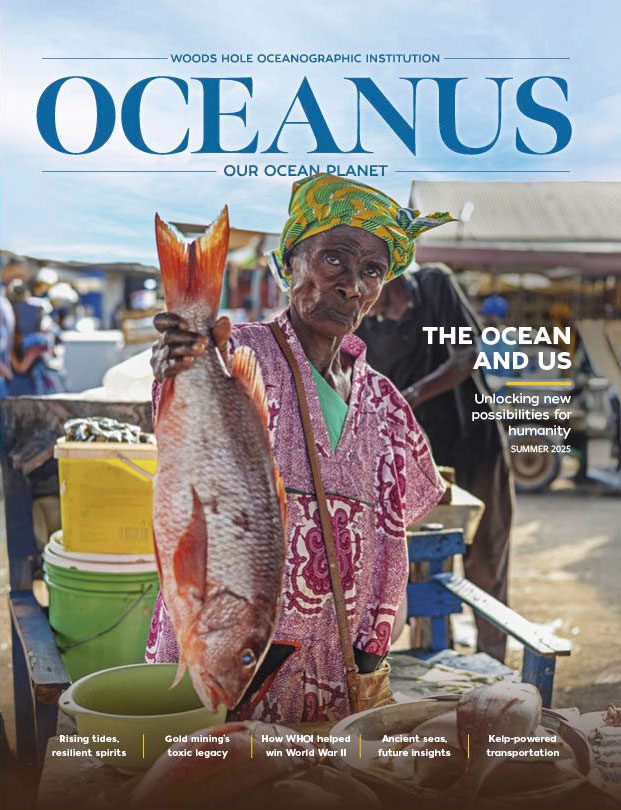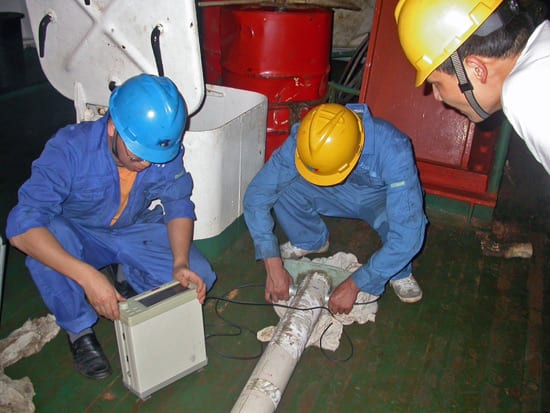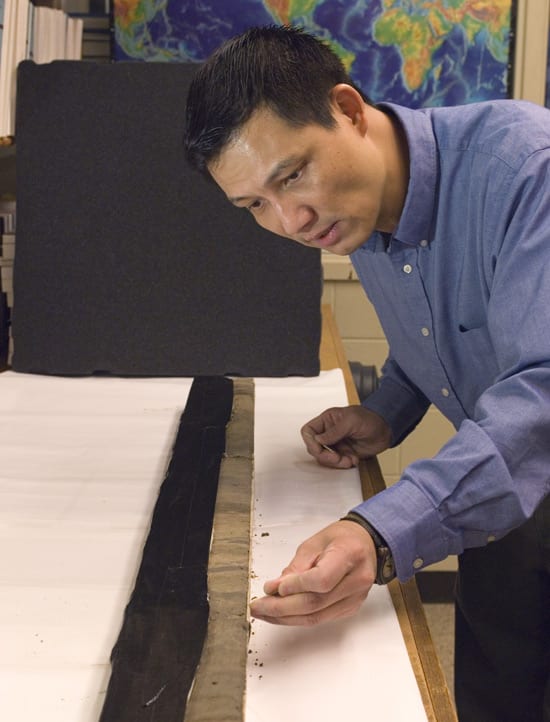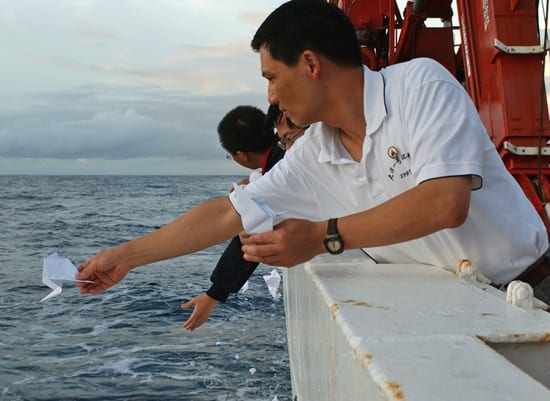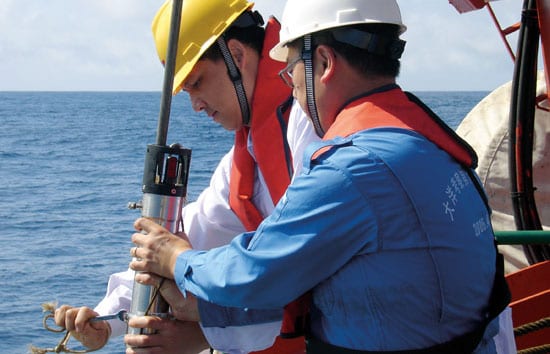
A ‘Book’ of Ancient Sumatran Tsunamis
Historic Chinese cruise brings back clues to old earthquakes and new vent sites
Exactly one year after the devastating 2004 Indian Ocean tsunami, Jian Lin found himself on a Chinese research vessel off Sumatra, floating above the epicenter of the seafloor earthquake that spawned the great wave.
He participated in a solemn ceremony to honor the estimated 280,000 people killed by the tsunami. Then he hauled up cores of ancient sediment from the ocean bottom—cores that could reveal the history of tsunamis, help predict their likelihood, and perhaps save lives in the future.
“You are looking at a book,” said Lin, a geophysicist, pointing to a 1½-meter-long column of mud in his office at Woods Hole Oceanographic Institution. “Now we must learn to read the pages and hope it contains chapters that will teach us how—and how frequently—earthquakes create tsunamis in this region.”
The tantalizing sediment samples culminated two 40-day voyages for Lin as U.S. chief scientist aboard China’s new research ship, Dayang 1. It was the first time an American scientist has been invited to co-lead a Chinese deep-ocean research cruise (see Worlds Apart, But United by the Oceans).
'Sniffing' to find new seafloor vent sites
During 2005, Dayang 1 sailed an ambitious 300-day series of expeditions to explore mineral and biological resources in the ocean, particularly at hydrothermal vents. To this unique collaboration, Lin brought seafloor maps from previous WHOI expeditions and a WHOI-built deep-tow magnetometer to detect mineral-rich ocean crust around vents. He also brought six Miniature Autonomous Plume Recorders (MAPRs), on loan from Edward Baker, Lin’s colleague at the National Oceanic and Atmospheric Administration.
Lin described MAPRs as “sniffers.” Lowered on wires into the depths, they detect hot, buoyant, particle-filled fluids emitted from seafloor vents. The fluids rise several hundred meters above the seafloor and spread sideways into mushroom-shaped plumes above the vent “stems.” MAPRs measure temperature, as well as the scattering of light (by dissolved particles) through seawater.
With these and other tools at their disposal, the international team aboard Dayang 1 discovered new regions of strong hydrothermal plumes in the eastern Pacific Ocean and atop of the Southwest Indian Ridge (SWIR). They also recovered microorganisms that live under extreme conditions in the deep ocean and many samples of sulfide rocks from hydrothermal vents. These represented firsts for China. By flying the magnetometer on an underwater vehicle only tens of meters above the seafloor, Lin and colleagues measured Earth’s magnetic field at very close range to determine the magnetic properties of unusual rocks found on the ultra-slow-spreading SWIR.
“The Indian Ocean cruise was probably the most fruitful expedition I have ever co-led,” Lin said. On a little-explored region of the SWIR, the MAPRs found a extremely robust hydrothermal plume, though the team did not have time to follow the plume trail to the vents that created it.
“This vent site is just waiting to be confirmed,” Lin said, “and scientists are now actively planning to go back as soon as possible. It would be the first large active vent ever found on the Southwest Indian Ridge and would fill in a missing geological and biological piece in the seafloor jigsaw puzzle.”
One year later, an unsettled ocean
In December 2005, Dayang 1 headed east toward Indonesia. Near the tsunami-generating earthquake site off Sumatra, the MAPRs found a surprise: One year after the tsunami, the bottom 2,000 feet (600 meters) of the ocean were still murky and filled with particles.
“Major seafloor earthquakes and tsunamis send huge amounts of seafloor sediments whirling into the ocean,” Lin said. “Our hypothesis was that big sediment grains would settle first, then medium grains, then fine grains, and then very fine grains.”
Stirred and sorted by tsunamis, the resettled fine-grained particles could leave telltale layers in sediments. “If we can find these layers in the cores I brought back, correlate them with previous known quakes, and date others deeper down in the cores,” Lin said, “then we may actually be able to read the history of earthquakes and tsunamis in this region.”
During a moment of silence in the tsunami memorial ceremony on Dayang 1, with everyone lined up on deck, “I thought about the immeasurable suffering of those affected by the tsunami,” Lin said, “and an enduring need to better understand and eventually forecast earthquakes and tsunamis.”
Then the ship’s horn blew for a full minute, and the ship’s party sank an inscribed concrete memorial to the tsunami victims into the sea. They cast origami cranes and flowers into the waves, as well as paper money, a Chinese tradition to pay respect to those in heaven.
Lin’s research was funded by the U.S. Office of Foreign Disaster Assistance and a WHOI Independent Study Award.
Slideshow
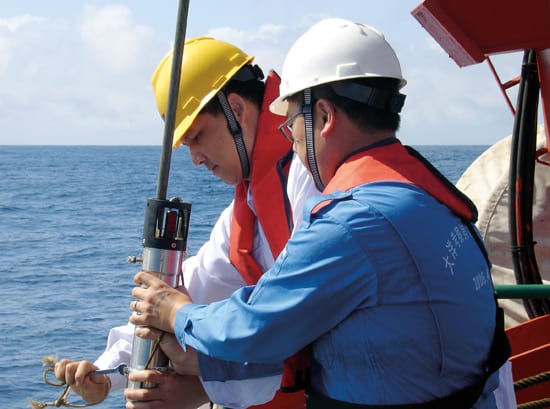
Slideshow
 Jian Lin (yellow hard hat), a geophysicist at Woods Hole Oceanographic Institution, was U.S. chief scientist aboard two voyages of China's new research vessel in 2005—the first American ever invited to co-lead a Chinese deep-ocean research cruise. He and Professor John Chen of Peking University deploy a Miniature Autonomous Plume Recorder to search for hydrothermal vents. (Photo by Mingyu Mi, China Central Television)
Jian Lin (yellow hard hat), a geophysicist at Woods Hole Oceanographic Institution, was U.S. chief scientist aboard two voyages of China's new research vessel in 2005—the first American ever invited to co-lead a Chinese deep-ocean research cruise. He and Professor John Chen of Peking University deploy a Miniature Autonomous Plume Recorder to search for hydrothermal vents. (Photo by Mingyu Mi, China Central Television)- WHOI scientist Jian Lin (right) looks at a sediment core just retrieved from the site of the seafloor earthquake off Sumatra that caused the 2004 Indian Ocean tsunami. Lin hopes the core contains a record of past tsunamis. (Photo by DayangYiHao, science party)
- Lin will analyze the sediment cores he retrieved from the seafloor off Sumatra to see if it can reveal a history of earthquakes and tsunamis in the region. (Photo by Tom Kleindinst, Woods Hole Oceanographic Institution)
- One year after the 2004 tsunami, with their research vessel above the site of the submarine earthquake that spawned it, Lin and the entire ship's crew participated in a solemn ceremony to commemorate the tsunami?s victims, casting origami cranes and flowers into the waves. (Photo by Hongjie Qiu, Xinhua News Agency)
Related Articles
- Can seismic data mules protect us from the next big one?
- A New Tsunami-Warning System
- Lessons from the 2011 Japan Quake
- How to Survive a Tsunami
- Morss Colloquia Focus on Science and Society
- Lessons from the 2004 Indian Ocean Tsunami
- MIT/WHOI Graduate Leads the World’s Tsunami Awareness Program
- Throwing DART Buoys into the Ocean
- Building a Tsunami Warning Network
Featured Researchers
See Also
- Finding Telltale Hydrothermal Plumes with MAPRs (Miniature Autonomous Plume Recorders) from Discover and Discover
- In the Tsunami's Wake, New Knowledge About Earthquakes from Oceanus magazine
- Tsunamis in the Caribbean? It's Possible from Oceanus magazine
